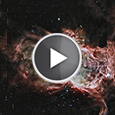CXC Home | Search | Help | Image Use Policy | Latest Images | Privacy | Accessibility | Glossary | Q&A
Tour of Flame Nebula
Quicktime MPEG With closed-captions (at YouTube)
Astronomers have made an important advance in the understanding of how clusters of stars like our Sun form using data from NASA's Chandra X-ray Observatory and infrared telescopes. The data show early notions of how star clusters are formed cannot be correct. The simplest idea is stars form into clusters when a giant cloud of gas and dust condenses. The center of the cloud pulls in material from its surroundings until it becomes dense enough to trigger star formation. This process occurs in the center of the cloud first, implying that the stars in the middle of the cluster form first and, therefore, are the oldest. These new results suggest something else is happening. By studying two clusters where Sun-like stars are forming - NGC 2024 (located in the center of the "Flame Nebula") and the Orion Nebula Cluster - researchers have discovered the stars on the outskirts of the clusters are actually the oldest. The researchers will use this same technique of combining X-rays and infrared data to study the age range in other clusters. In the meantime, scientists will be hard at work to develop other, more complex ideas to explain what they've seen in NGC 2024 and the Orion Nebula Cluster.
[Runtime: 01:32]
Quicktime MPEG With closed-captions (at YouTube)
Astronomers have made an important advance in the understanding of how clusters of stars like our Sun form using data from NASA's Chandra X-ray Observatory and infrared telescopes. The data show early notions of how star clusters are formed cannot be correct. The simplest idea is stars form into clusters when a giant cloud of gas and dust condenses. The center of the cloud pulls in material from its surroundings until it becomes dense enough to trigger star formation. This process occurs in the center of the cloud first, implying that the stars in the middle of the cluster form first and, therefore, are the oldest. These new results suggest something else is happening. By studying two clusters where Sun-like stars are forming - NGC 2024 (located in the center of the "Flame Nebula") and the Orion Nebula Cluster - researchers have discovered the stars on the outskirts of the clusters are actually the oldest. The researchers will use this same technique of combining X-rays and infrared data to study the age range in other clusters. In the meantime, scientists will be hard at work to develop other, more complex ideas to explain what they've seen in NGC 2024 and the Orion Nebula Cluster.
[Runtime: 01:32]
(Credit: NASA/CXC/A. Hobart)
Return to Flame Nebula (May 7, 2014)



